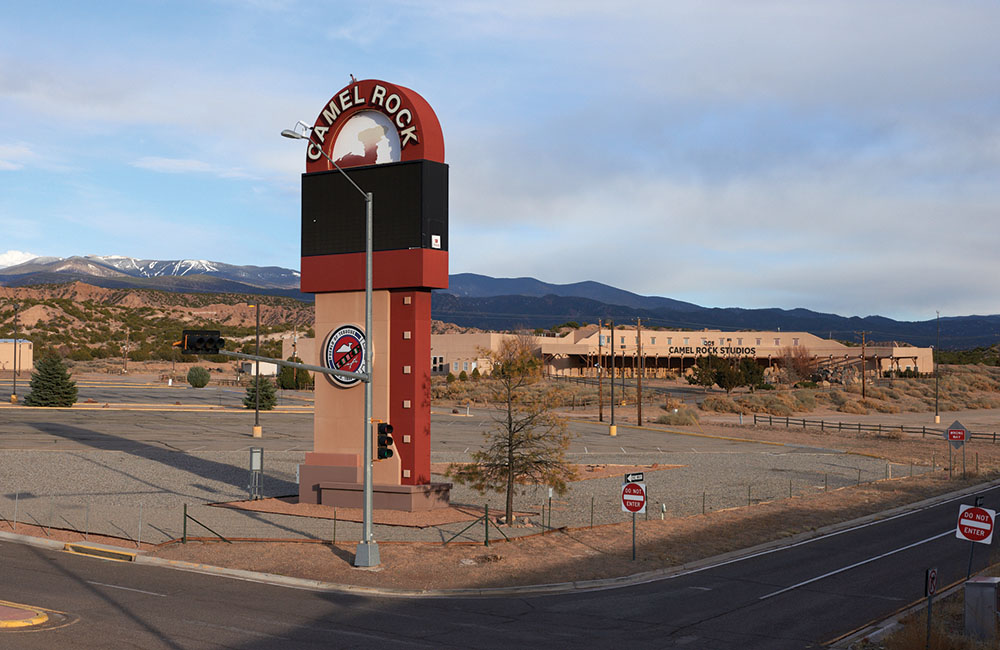
Built on the site of a former casino, Camel Rock Studios has a backlot with more than 100 acres of land in view of the Santa Fe National Forest and Sangre de Cristo Mountains.
Photographed by Damon Casarez

In 2018, the Tesuque Pueblo, a small Native American tribe based outside Santa Fe, New Mexico, was trying to decide what to do with their old casino. The tribe had built a new, updated gaming facility, and their economic development board was considering converting their 1950s-era casino lot into a water park, a ropes course or a glamping destination. Another, almost offhand suggestion the group entertained was opening a movie studio.
New Mexico was emerging as a production hotbed, luring films and TV shows with a strong tax incentive, deep crew base, sunny weather and short flights to L.A. Netflix has committed to spending more than $1 billion on production in the state and is expanding its studio in Albuquerque, and Universal has pledged to spend $500 million. But in addition to the possible economic benefits for the Tesuque, the studio brought the promise of something potentially even more compelling — the chance to have a hand in shaping the image of Indigenous people onscreen.
“We can at least be at the table to help guide, to get away from the stereotypical Hollywood portrayal,” says Roman Duran, a member of the Tesuque Pueblo and the chair of the tribe’s advisory committee for the studio, which they named Camel Rock. “We can be, I guess, an influencer is the terminology nowadays, and advocate for Native American representation at all levels.”
Before the studio even officially got off the ground, they had a high-profile production in their space, Universal’s 2020 Western News of the World. That movie, directed by Paul Greengrass and starring Tom Hanks, used the casino for prop storage, set construction and production offices, and built a tank in the parking lot for a greenscreen sequence of a river crossing.
Because the Tesuque land is its own nation, productions that shoot here are not eligible for New Mexico’s tax incentives, but Camel Rock Studios quickly booked a long-term second tenant in the new AMC show Dark Winds, which built a backlot with a Navajo village, caves and a house for its lead character, Detective Joe Leaphorn. “What everybody fell in love with was the fact that we were able to shoot on tribal land,” says Chris Eyre, executive producer and director of the show. “We’re putting money into a tribal economy, diversifying their businesses. If we’re going to make Native content, let’s do it right.”

Built on the site of a former casino, Camel Rock Studios has a backlot with more than 100 acres of land in view of the Santa Fe National Forest and Sangre de Cristo Mountains.
Photographed by Damon Casarez

The studio is named after Camel Rock, a distinctive pink sandstone landmark resembling a camel (its “head” shown) that has appeared as a setting in movies and TV shows, including the 1955 Jimmy Stewart Western The Man From Laramie and the animated Netflix show Bojack Horseman.
Photographed by Damon Casarez

Dark Winds used the lobby of the former casino, which has historical pictures of the pueblo and paintings by traditional Tesuque artist Paul Vigil, for a scene set at a cultural center.
Photographed by Damon Casarez

Props used for AMC’s Dark Winds, which is based on a series of detective novels by Tony Hillerman set in the Navajo Nation during the 1970s.
Photographed by Damon Casarez

Spaces in the former casino have been repurposed, with an old bingo hall outside turned into a mill and, pictured here, a former lounge being used as a set decorator’s storage area.
Photographed by Damon Casarez

The former ’50s-era casino entrance. “We’d like to advocate for Native American representation at all levels in the film industry,” says Duran. “We can be an influencer.”
Photographed by Damon Casarez

Duran and Mitchell outside a set used for Dark Winds. The Tesuque Pueblo considered building a water park or glamping spot before deciding a studio would benefit the community most.
Photographed by Damon Casarez
This story first appeared in the June 1 issue of The Hollywood Reporter magazine. Click here to subscribe.